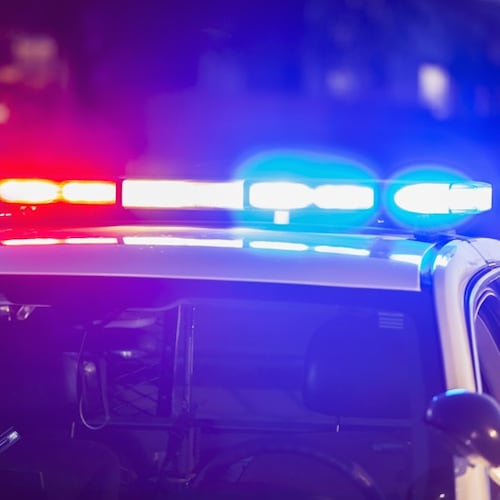One assumption about traffic reporters is that all of us fly in a helicopter. In fact, most — almost all — do not. Smilin’ Mark McKay, Ashley Frasca, and I are the only airborne traffic reporters left in Atlanta. McKay is in the WSB Skycopter each morning drive and I take flight in the afternoons. Frasca has recently gotten the chance to fill in for us, as she gets the feel of both looking at traffic from above and arranging and leading the WSB Triple Team Traffic reports for the rest of the team on the ground.
» RELATED: Gridlock Guy: WSB Triple Team Traffic App helps navigate commute
But none of us has a pilot’s license. We have a rotation of pilots, led by our Monday-through-Thursday stalwart Bob Howdy, a former police officer who prefers that pseudonym. And we carry a videographer on each flight, Brett Barnhill, who has the responsibility of providing a feed that all four TV news stations in Atlanta use. This cross-pollination allows us to stay airborne, but this balance with the needs of TV stations also can influence where we fly.
Credit: Doug Turnbull, WSB Skycopter
Credit: Doug Turnbull, WSB Skycopter
I recently got a question from a WSB listener and viewer about how we decide where to go. I had not explained that in a while, so I found it a worthy topic for this column.
The pilot has the ultimate say in where we fly. If they have to avoid busy airspaces around airports or cannot lift off in bad weather, that is their call. Regardless of how bad the weather is, they always drive in and make that call from the hangar at DeKalb-Peachtree Airport. There are so many stimuli to consider as a pilot that we would have no way as reporters of doing that job simultaneously. We do traffic every six minutes and they carry in their hands life or death; we “let” the pilots fly.
When TV stations have special video requests or if we find something that the other stations want, Barnhill has to check with his producer on the ground to make sure to stay at those scenes long enough. If, say, I am ready to move to another problem, we cannot go until Barnhill is cleared. Balancing the demands he receives with what we want for News 95.5/AM750 WSB makes both of our jobs harder, but the reward of flying is worth the pause.
All else being equal — i.e., when we do not have to wait for TV — we are a traffic helicopter. And that is more than 90% of the time. So we simply fly up and down the interstates when there aren’t any big wrecks or news stories that alter our routes. We generally do not go south of I-20, because Hartsfield-Jackson’s airspace is so wide. We have to make such a wide route to fly to McDonough or Fairburn that going that way isn’t worth the time cost, unless there is a big problem. In this past week, however, we have flown to the south side multiple times for different traffic issues.
» RELATED: Gridlock Guy: When traffic is stopped and you need to go
We try to make our decisions to maximize our time flying over interstates, in hopes that we discover something new. Finding a crash that we didn’t already know about in the WSB 24-Hour Traffic Center “pays” for the whole two-hour ride in the Skycopter. We take the airborne advantage seriously and want to leverage it to help Atlanta commuters to the greatest extent. Earlier this month, we flew over a wreck during PM drive on I-85/northbound at Jimmy Carter Blvd. It took forever to clear, and the Traffic Team had a live ground shot of it on the WSB Jam Cam. But we stayed over it to get more detail and see the impact on surrounding roads. We noticed that commuters heavily underutilized Oakbrook Pkwy. as an alternate and started telling traffic to go there. Observing small details like that or something in a wreck that might make the clean-up last longer are the added value we can still give. And that is value that automated traffic apps still do not offer. Common sense is a great human trait.
With technology becoming smarter and more superfluous, we tailor our flight paths differently. If we know that the Traffic Team has a good feel on a wreck without us flying over it, we don’t waste the fuel going there. We try to maximize our advantage. News helicopters generally fly a la carte to stories, whereas the WSB Skycopter flies for a couple of hours each morning and afternoon drive. Some days are very humdrum, but others see major problems. In a city with traffic jams like ours, WSB knows the importance of staying airborne in the Skycopter.
In this time of automation, we have seen news organizations wave white flags for traffic reporting. They outsource it to bigger companies that assign one reporter to five stations and who just read crashes. We cover multiple stations in the WSB Traffic Center, but they are all local and we do it with the best tools and the most expertise in the city. We know your ride is important and we want the information you need to come at you constantly on radio, TV, online, on social media, and on the Triple Team Traffic Alerts App. The WSB Traffic Team is still on offense against Atlanta gridlock, and the WSB Skycopter is a huge weapon.
» RELATED: Gridlock Guy: Residential cost of GA-400 expansion illustration of bigger conundrum
Doug Turnbull, the PM drive Skycopter anchor for Triple Team Traffic on News 95-5 FM and AM-750 WSB, is the Gridlock Guy. He also writes a traffic blog and hosts a podcast with Smilin’ Mark McKay on wsbradio.com. Contact him at Doug.Turnbull@coxinc.com.
About the Author
The Latest
Featured


